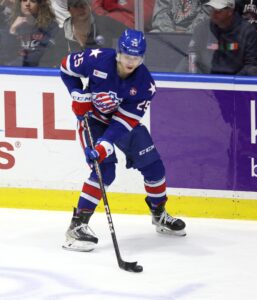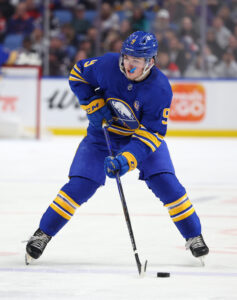The Buffalo Sabres face their final seven games of the season well outside of the playoff conversation. It’s been a disappointing year for one of the league’s hottest teams at the end of the 2022-23 campaign. Nobody has stepped up, with Tage Thompson not yet at 50 points after scoring 94 last year; Devon Levi struggling to hold onto the starter’s net amid less-than-flattering competition; and the defense continuing to falter when faced with too much pressure.
The down-year has forced general manager Kevyn Adams to part with important morale pieces, sending team captain Kyle Okposo to the Florida Panthers and former Colorado Avalanche assistant captain Erik Johnson to the Philadelphia Flyers. And the Sabres might’ve moved even more veterans, with Zemgus Girgensons and Victor Olofsson reportedly on the trade block as well. Even if it wasn’t their intention at the beginning of the year, the Sabres now sit with a clear mindset – get younger, and then we’ll get better. That’s not a new perspective in the NHL, but it is a risky path forward. Few teams have the depth to refresh lineup roles solely from within. But after years of strong, and lucky, drafting, the Sabres could be one of the rare few to pull it off.
The Buffalo Sabres Future Playoff Hopes Lie With Their Prospects
Buffalo’s prospect pool is led by centerman Jiri Kulich, who has served as one of the top forwards for the AHL’s Rochester Americans. He’s scored 21 goals and 38 points through 49 games this season, improving on his scoring pace after 24 goals and 46 points in 62 games last year. Kulich has added the boost in scoring while also taking on more and more responsibility, becoming a centerman capable of staying diligent in all three zones. He’s been a favorite of Rochester head coach Seth Appert, spending the last two seasons working with Rochester’s development team to find what specific program will best support the Czechian power forward – knowing that Kulich won’t shy away from hard work. The Sabres will hope that next season bears the fruits of Appert’s labor, with the departure of Casey Mittelstadt opening up opportunity down the middle. Kulich looked undoubtedly overeager in his NHL debut earlier this season, showing a clear need for added poise and experience. He’s gathered plenty now on a Rochester team bound for the AHL playoffs, though if it will be enough to seamlessly transition into the NHL is yet to be seen. As are the consequences if Kulich isn’t ready.
and 38 points through 49 games this season, improving on his scoring pace after 24 goals and 46 points in 62 games last year. Kulich has added the boost in scoring while also taking on more and more responsibility, becoming a centerman capable of staying diligent in all three zones. He’s been a favorite of Rochester head coach Seth Appert, spending the last two seasons working with Rochester’s development team to find what specific program will best support the Czechian power forward – knowing that Kulich won’t shy away from hard work. The Sabres will hope that next season bears the fruits of Appert’s labor, with the departure of Casey Mittelstadt opening up opportunity down the middle. Kulich looked undoubtedly overeager in his NHL debut earlier this season, showing a clear need for added poise and experience. He’s gathered plenty now on a Rochester team bound for the AHL playoffs, though if it will be enough to seamlessly transition into the NHL is yet to be seen. As are the consequences if Kulich isn’t ready.
But Kulich won’t be able to escape the competition with fellow AHL sophomore Isak Rosen by moving to the NHL. Rosen has looked just as capable in his pro appearances, even earning seven NHL games to Kulich’s one this season. The 21-year-old winger has 16 goals and 40 points in 59 AHL games this year, topping his 37 points in 66 games last year. And he’s managed it on the back of growing confidence with the puck on his stick. Rosen has always made himself a focal piece of the offense, but he found a new layer of poise this season, doing much better at slowing play down and creating space when opportunity isn’t present, instead of forcing through a failed entry. But while his AHL play has improved thanks to better independence, Rosen’s NHL game suffered from a severe lack of involvement. He’s yet to score his first NHL point and did little to look convincing in his outings. There’s definite room for confidence – with Rosen never looking downright bad or out of place at the top level – but he’ll need to find his drive amidst the best in the world if he wants to succeed. Rosen took a couple of years to find his footing in the minors and could need the same slow transition into the NHL. That means the Sabres will have to be patient, as Rosen likely starts in a smaller role and works his way up next season. Already struggling for wins, it will be interesting to see if Buffalo has the time to spend.
Kulich and Rosen are joined at the top of the depth chart by Matthew Savoie, who returned to the WHL after one NHL game and six AHL games. He scored five points in the latter matchups, and carried the strong scoring back into juniors, where his 30 goals and 71 points in 34 games (2.09 points-per-game) marked the highest rate any WHL player has scored at since Connor Bedard last season, and Mike Comrie in 2001 before him. To join such an exclusive list is always exciting, and Savoie is certainly deserving, proving this year that his high-tempo playmaking is simply too good for the CHL. It seems opportunity is the last remaining piece of Savoie’s puzzle, especially considering his AHL success earlier this season. But pre-season injury marred Buffalo’s ability to really test him at the top level. They’ll have to go through the feeling-out process at the start of next year, while also hoping Savoie can quickly turn the tides on the scoresheet. His tempo and skill were dominant in juniors and could certainly bring the game-changing offense that Buffalo is in dire need of. A bill of good health this summer and confidence this fall could set up Savoie for a prime role as soon as next year kicks off.
Buffalo has plenty of other forward prospects that could push the envelope soon. Viktor Neuchev carried a steady AHL role all season long, despite being in his first season of North American pros. He, as well as Swedish duo Anton Wahlberg and Noah Östlund, will all continue to get comfortable through minor league roles next season. It’s instead defenseman Ryan Johnson that rivals one of Buffalo’s remaining NHL slots. Johnson is playing through his first professional season this year, with seven assists in 41 NHL games and eight assists in 19 AHL games – though he’s still searching for his first pro goal. And while he’s adjusted well, there’s been plenty left to desire from the 22-year-old defenseman. He’s simply yet to find where his impact comes in – showing strength in a long list of roles but yet to stamp one as his calling card. It was his ability to control the offensive zone, and control possession, that propelled Johnson through college. He’s shown flashes of that ability in the NHL as well, though they’ve been coupled by a clear need for quicker decision making and sharper plays. The Sabres will hope he can find his offensive niche in the NHL quickly, with Johnson leading a very depleted defensive depth chart. If he can’t solidify an NHL role next year, the team might be forced to turn towards the draft to try and mend a blue-line that’s looked unconfident for years.
 Zach Benson lit the Sabres on fire this year. While he’s only managed 23 points on the season, he’s shown a determination and work ethic that’s hard to find, especially in 18-year-olds straight out of juniors. Buffalo needs more of that prospect luck next season, if they want to reignite the fire under their playoff hopes. Savoie represents plenty of upside, while Kulich and Rosen could each carve out strong roles of their own, but all three players face questions. How they can overcome that uncertainty, as well as how quickly Buffalo’s able to add in impactful defensive depth, will be the defining questions as the Sabres look to build a winning team from within.
Zach Benson lit the Sabres on fire this year. While he’s only managed 23 points on the season, he’s shown a determination and work ethic that’s hard to find, especially in 18-year-olds straight out of juniors. Buffalo needs more of that prospect luck next season, if they want to reignite the fire under their playoff hopes. Savoie represents plenty of upside, while Kulich and Rosen could each carve out strong roles of their own, but all three players face questions. How they can overcome that uncertainty, as well as how quickly Buffalo’s able to add in impactful defensive depth, will be the defining questions as the Sabres look to build a winning team from within.
Photos courtesy of USA Today Network.